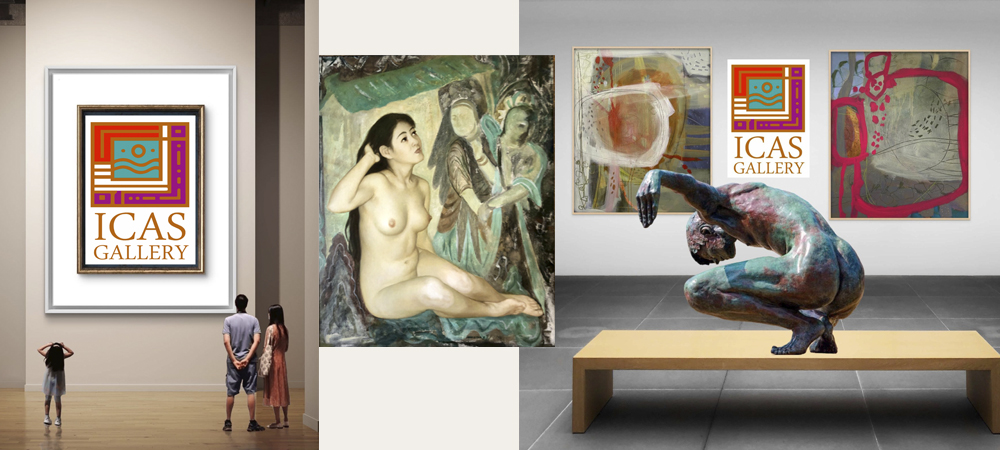“East Meets West: A Feminine Dialogue – From Chinese Folklore to Botticelli’s Venus”
Featured at ICAS Vilas Art Gallery
One of the current highlights at the ICAS Vilas Art Gallery is a captivating piece by a contemporary Chinese figurative painter. This work features a seated female nude, depicted with grace and quiet vulnerability, drawing inspiration from folkloric storytelling and rural life. Set against the backdrop of an old Chinese village surrounded by dense woodland, the painting emanates a haunting stillness, inviting viewers to engage in a serene yet emotionally charged moment of reflection. The subject, a solitary woman who is unclothed yet unashamed, embodies not just physical beauty but also cultural significance. Her figure, softly illuminated by ambient light, encourages contemplation rather than voyeurism. Her nudity is not presented as erotic; instead, it evokes a sense of ancestral purity and spiritual resilience. The earth-toned palette, textured brushwork, and rich atmospheric layering pay homage to traditional ink painting while embracing the sensuality of oil. The surrounding environment, characterised by weathered architecture, faded walls, and a forest that seems to whisper ancient secrets, firmly anchors the figure in a world that is both historically rich and deeply personal. This woman is not a goddess from mythology, but rather a representative of the soil, a vessel of stories that have been passed down through generations. Her presence embodies the legacy of Chinese femininity: strong, enduring, and deeply intertwined with the land and the community.
A Comparison: Botticelli’s Venus and the Eastern Muse
When we compare Sandro Botticelli’s *The Birth of Venus* (c. 1485) with a Chinese figurative painting at ICAS, we find a fascinating dialogue between cultural ideals of beauty, myth, and meaning. Botticelli’s Venus, born from the sea and carried on a shell, represents divine and idealised beauty. She exists outside of time, untouched by the hardships of earthly life. Her nudity is celestial, symbolising love, grace, and the rebirth of Classical antiquity through Renaissance humanism. In contrast, the Chinese painting presents a realism that is deeply rooted in the sacred yet mundane rhythms of village life. While Venus embodies myth, the seated nude reflects memory and the weight of lived experience. Botticelli offers perfection in an ethereal realm, whereas the Chinese artist depicts a woman grounded in her place and ancestry. Despite these differences, there are common threads: both figures convey serenity and an internal world that remains untouched by the viewer’s gaze. They both use the female form to explore ideals, not just of beauty, but also of harmony with nature and the human condition. Botticelli’s Venus floats on an ocean breeze, while forest winds shelter the Chinese nude; both evoke the eternal feminine archetype, albeit from vastly different perspectives.
 Bridging Cultures Through Art
Bridging Cultures Through Art
This contrast highlights the ability of figurative art to transcend borders while honouring cultural specificity. At the ICAS Vilas Art Gallery, this contemporary Chinese painting invites viewers into a meditative space, encouraging them to reflect on how beauty is shaped by heritage, mythology, and environment. As a result, it serves as a quiet yet profound counterpoint to the Western canon, not in opposition but as part of a meaningful dialogue. In this way, ICAS continues its commitment to showcasing global art that bridges time, place, and tradition, reminding us that the language of the figure is universal yet endlessly diverse.




